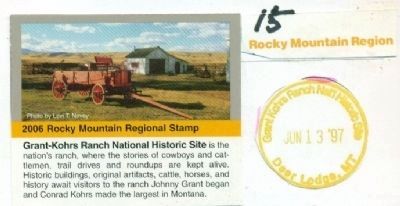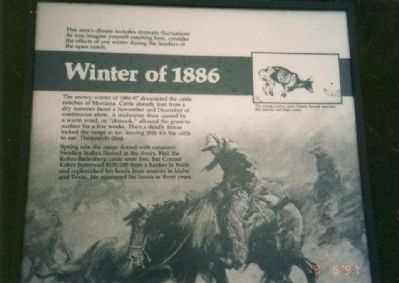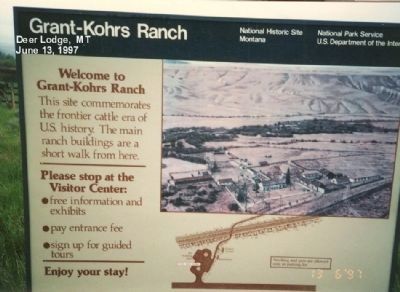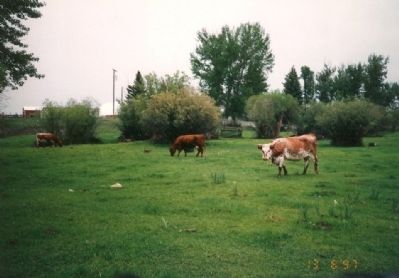Winter of 1886
Grant-Kohrs Ranch National Historic Site
— National Park Service, U.S. Department of the Interior —
The snowy winter of 1886-87 devastated the cattle ranches of Montana. Cattle already lean from a dry summer faced a November and December of continuous snow. A midwinter thaw caused by a warm wind, or “Chinook,” allowed the grass to surface for a few weeks. Then a deadly freeze locked the range in ice, leaving little for the cattle to eat. Thousands died.
Spring saw the range dotted with carcasses. Swollen bodies floated in the rivers. Half the Kohrs-Bielenberg cattle were lost, but Conrad Kohrs borrowed $100,000 from a banker in Butte and replenished his herds from sources in Idaho and Texas. He recovered his losses in three years.
The young cowboy-artist Charlie Russell sketched this famous and tragic scene.
Erected by National Park Service.
Topics. This historical marker is listed in this topic list: Notable Places.
Location. 46° 24.474′ N, 112° 44.226′ W. Marker is in Deer Lodge, Montana, in Powell County. Marker is on Warren Lane. Touch for map. Marker is in this post office area: Deer Lodge MT 59722, United States of America. Touch for directions.
Other nearby markers. At least 8 other markers are within walking distance of this
Regarding Winter of 1886. GRANT-KOHRS RANCH
History & Culture
"They were a rugged set of men, these pioneers, well qualified for their self-assumed task. In the pursuit of wealth a few succeeded and the majority failed,...the range cattle industry has seen its inception, zenith, and partial extinction all within a half-century. The changes of the past have been many; those of the future may be of even more revolutionary character."
Conrad Kohrs, 1913
Dreams of wealth lured the first cattle men to Montana. The range was open and unfenced, and they could fatten their cattle on the lush bunchgrass and push on to new pastures when the old areas were overgrazed. The main obstacles were
Many of the herds were built through trade with westward-bound emigrants, who gladly swapped two or more trail-worn cows for a single well-fed one. In the late 1870's cowboys drove herds of rangy longhorns up from Texas to the better grazing lands of Montana, adding a Spanish strain to the English shorthorn breeds already established there and greatly multiplying the herds.
By 1885, cattle raising was the biggest industry on the High Plains, and foreign investors and eastern speculators rushed to get in on the bonanza. As ranches multiplied and the northern herds grew, there came a predictable consequence: overgrazing. This and the fierce winter of 1886-87 caused enormous losses, estimated at one-third to one-half of all the cattle on the northern plains. Many cattlemen never recovered.
If the snows of '86-87 foreshadowed the end of open range ranching, the homesteaders, with their barbed wire and fenced-in 160 acre claims, finished it off.
The open-range cattle industry lasted only three decades. Few of its pioneering men and women made their fortunes or are remembered today. But from their beginnings has evolved the more scientific ranching of today, with its own risks and uncertainties. That is the legacy of the Grants and the Kohrs, whose pioneer ranch, complete with original furnishings, is a reminder of an important chapter in the history of the West.
(Information above obtained from the National Park Service website)

Credits. This page was last revised on June 16, 2016. It was originally submitted on December 22, 2012, by Don Morfe of Baltimore, Maryland. This page has been viewed 838 times since then and 28 times this year. Photos: 1, 2, 3, 4. submitted on December 22, 2012, by Don Morfe of Baltimore, Maryland. • Bill Pfingsten was the editor who published this page.


